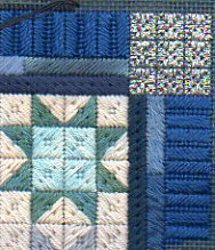How to Convert Cross Stitch to Needlepoint

When first asked if it was possible to use a cross stitch chart as a needlepoint chart I thought the process would be so easy that there was no need for explanation at all. However, I always do my research and never assume anything! Although it is not a difficult switch, it is one you do need to think about before just jumping in.
Cross stitch is made of basically a right angled half stitch and a left angled half stitch used together to create that X stitch. Needlepoint and plastic canvas use these same stitches as the Continental and Alternating Continental (when crossed these two stitches create the Cross Stitch) along with Scotch Stitch, Slanting Gobelin, and Long Stitch. Many cross stitch charts can be used as is; you decide if you want to use only the slanting stitches or a full cross stitch.
Experts say to check all diagonal lines within the pattern or design. Diagonal lines slanted up and to the right translate well when converting from cross stitch to needlepoint.
If you want to convert a cross stitch pattern to a needlepoint pattern, it’s best if there are not a lot of back or decorative stitches to be done, unless you can complete the pattern without using these stitches. So take a good look at any photos of the finished pattern or any symbol charts.
You should also keep in mind that a majority of cross stitch patterns or designs use the material or fabric used as the background whereas in needlepoint the entire pattern or design is stitched. If converting a cross stitch pattern into a needlepoint design you’ll need to decide if you are going to want to stitch the background. Any filling needlepoint stitch can be used. Most experts agree that it’s best to start at the center of a design and work out.
Up Next:
Read NextWoodcut Rose















